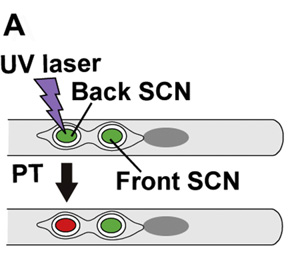Image of the month (May 2011)
Sperm cells labeled with photoconvertible fusion protein in Arabidopsis pollen tubes


These images are from a research article that was recently published in Current Biology (March 2011).
Article reference:
Live-cell imaging reveals the dynamics of two sperm cells during double fertilization in Arabidopsis thaliana.
Hamamura Y, Saito C, Awai C, Kurihara D, Miyawaki A, Nakagawa T, Kanaoka MM, Sasaki N, Nakano A, Berger F, Higashiyama T.
Division of Biological Science, Graduate School of Science, Nagoya University, Furo-cho, Chikusa-ku, Nagoya, Aichi 464-8602, Japan.
Curr Biol. 2011 Mar 22;21(6):497-502.
In this article, the authors used a live cell imaging system to characterize the sperm cell migration, delivery and fertilization in Arabidopsis. One of the questions that have been addressed only to a partial extent in Arabidopsis is whether both sperms cells in Arabidopsis pollen tubes are equally functional. To examine this question further, the authors devised a scheme in which they can differentially label the two wild-type sperm cells and image wild-type double fertilization in their live-cell imaging system. Improtantly, this strategy avoided the use of mutants and addressed this question directly in a system that has a full complement of two male and two female gametes.
The scheme they devised is as follows (top image): Photoconvertible fluorescent protein, a monomeric Kikume Green-Red (mKikGR) variant, fused to HTR10 was expressed from a sperm-specific promoter. As envisioned, the fusion protein was correctly expressed in both sperm nuclei (gree spots, left panel on the bottom image). Subsequently one or the other sperm nuclei were bombarded with laser to induce photoconversion into a different color (red spot, right panel on the bottom image). The authors then followed the fate of the two sperm nuclei after photo conversion.
From their experiments, they concluded that (quoting from the article) "the isomorphic sperm cells of Arabidopsis do not show a preference with regard to fertilization targets based on their position in the male germ unit". For addtional details, please see the article by Hamamura et al (2011): Curr Biol. 2011 Mar 22;21(6):497-502.
-----------------------------------------------------------------------------
Click here for previously featured image of the month.
|